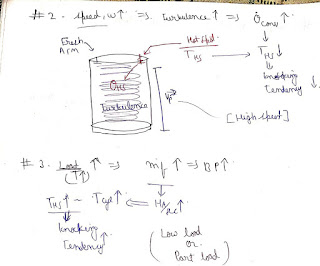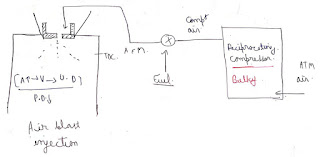Combustion science
Combustion in SI engine
First stage of combustion
- When sparking begins contact takes place between spark and the nearest fuel particle layer and its chemical reaction begins.
- Due to chemical reaction there is rise in temperature of the nearest fuel particle layer and at the same instant of time due to the temperature difference between the nearest fuel particle and next fuel particle layer there is heat transfer in the form of radiation occurs. Figure 3.1.
- When the temperature of the nearest fuel particle layer becomes equal to or above its fire point temperature then at the end of its chemical reaction there is rise in temperature, reaches to its fire point and ignition begins ,figure 3.2.
- Flame front : ignited fuel particle at the same instant of time.
- After the formation of the first flame front, the heat from this flame front ignites the next fuel particle layer and another flame front will be formed.
- It appears like that the first flame front only has reached the new position and this imagination of flame front forward motion is termed as propagation of flame front.
Abnormal combustion in SI engine
- End charge : the air and fuel mixture at the other end of the spark plug is termed as end charge.
- Hotspot : any localise high-temperature region or space example exhaust valve.
- During the propagation of the flame front following operation takes place on the end charge figure 1.
- Due to radiation heat transfer from the flame front, it increases the end charge temperature. Due to the expansion of the air-fuel mixture near the flame front ,it compresses the end charge.
- If there is any hotspot then it will increase the end charge temperature further.
- Due to the above reason, if the temperature of the end charge become more than and equal to it self ignition temperature than a separate flame front will be formed from the hotspot.
- Then these two flame front will collide with each other and it create high energy shock wave. Which is unable to handle by piston and cylinder assembly and this phenomenon is termed as detonation / knocking / pinging .(generally detonation in SI engine and knocking in CI engine).
Compression ratio
- If the compression ratio will increase then it will increase the temperature of the air-fuel mixture after the compression which results in to the higher temperature of the end charge it means the chemical delay will be lesser and tendency of knocking will increase.
- The lower compression ratio is preferred in CI engine due to the knocking tendency whereas theoretically it will increase the cycle efficiency.
- According to the designer point of view the compression ratio should be as high as possible but within the range.
- Supercharging is more preferred in CI engine as compared to assign engine because of knocking tendency.
- Distance of flame travel : the bore of the petrol engine is restricted up to 12 centimetre for the better performance by reducing knocking tendency or by decreasing time taken by the flame front to reach end charge before the self ignition of the end charge.
- Chemical structure (fuel structure)
- Location of spark plug
- Advancing of spark timing : When the sparking will advance then it will take place little earlier than the correct timing, hence the sparking will exist for more time period. It means more energy will be given to the AFM which actually increases the temperature of the end charge.
- Fuel quality or fuel rating
- Octane rating : it is a measure of fuel ability to resist the knock it means higher the octane number lesser is a probability of self ignition of end charge Hence compression ratio can be more than 12 with higher octane number fuel.
NOx emission
- NOx emission from an IC engine is because of the
- Oxygen availability
- Excessively high temperature inside the cylinder.
- UBHC (unburned hydrocarbon)
- CO (carbon monoxide)
- NOx
- Valve overlap is the period during the valve timing when both intake and exhaust valve are open which is occurring towards the end of the exhaust stroke and beginning of the suction stroke.
- Valve overlap is the secondary means to cool exhaust valve with the intake gas during the suction stroke and it is more suitable for CI engine.
- During the valve overlap period inlate gas enter into the cylinder and it thrown out the exhaust gas out of the combustion chamber and this phenomenon is termed as a scavenging, which is more suitable for CI engine.
- Valve overlap is more in CI engine as compared to SI engine.
Catalytic converter
- Its a steady state device made up of alumina Al2O3 in honeycomb structure to increase the surface area of contact between catalyst and exhaust gas ,in catalytic converter three catalyst rhodium, Palladium and platinum is used to reduce the amount of energy required for the reduction of NOx, oxidation of carbon monoxide and oxidation of unburned hydrocarbons respectively.
Note : fuel additives
Knocking in CI engine- Knocking in CI engine is based on the ignition delay criteria and to reduce knocking tendency , the ignition delay should be less as compared to SI engine.
- Airblast injection is a historical injection system for diesel engine in which simple low pressure fuel pump is used with the blast of compress air from the compressed air tank by the use of heavy compressors.





































0 Comments